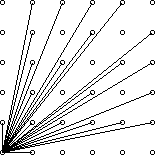[数论] POJ 3090/HOJ 2416 Visible Lattice Points 欧拉函数
来源:互联网 发布:淘宝全景图体验app 编辑:程序博客网 时间:2024/05/22 13:17
传送门:Visible Lattice Points
Description
A lattice point (x, y) in the first quadrant (x and y are integers greater than or equal to 0), other than the origin, is visible from the origin if the line from (0, 0) to (x, y) does not pass through any other lattice point. For example, the point (4, 2) is not visible since the line from the origin passes through (2, 1). The figure below shows the points (x, y) with 0 ≤ x, y ≤ 5 with lines from the origin to the visible points.

Write a program which, given a value for the size, N, computes the number of visible points (x, y) with 0 ≤ x, y ≤ N.
Input
The first line of input contains a single integer C (1 ≤ C ≤ 1000) which is the number of datasets that follow.
Each dataset consists of a single line of input containing a single integer N (1 ≤ N ≤ 1000), which is the size.
Output
For each dataset, there is to be one line of output consisting of: the dataset number starting at 1, a single space, the size, a single space and the number of visible points for that size.
Sample Input
4245231
Sample Output
1 2 52 4 133 5 214 231 32549
Source
解题报告:
先画一条(0, 0)到(n, n)的线,把图分成两部分,两部分是对称的,只需算一部分就好。
取右下半,这一半里的点(x, y)满足x >= y
可以通过欧拉函数计算第k列有多少点能够连到(0, 0)
若x与k的最大公约数d > 1,则(0, 0)与(x, k)点的连线必定会通过(x/d, k/d),就被挡住了
所以能连的线的数目就是比k小的、和k互质的数的个数,然后就是欧拉函数。
代码如下:
#include<stdio.h>int eular(int n){ int ret=1,i; for(i=2;i*i<=n;i++) if (n%i==0){ n/=i,ret*=i-1; while (n%i==0) n/=i,ret*=i; } if (n>1) ret*=n-1; return ret; //n的欧拉数}int main(){int test;int n;int i;int ans;int t=0;scanf("%d",&test);while(test--){ans=0;scanf("%d",&n);for(i=2;i<=n;i++)ans+=eular(i);printf("%d %d %d\n",++t,n,ans*2+3);}return 0;}- [数论] POJ 3090/HOJ 2416 Visible Lattice Points 欧拉函数
- POJ 3090 Visible Lattice Points 欧拉函数
- POJ 3090 Visible Lattice Points 欧拉函数的应用
- POJ 3090 Visible Lattice Points(欧拉函数)
- POJ 3090 Visible Lattice Points 欧拉函数
- POJ 3090 : Visible Lattice Points - 欧拉函数
- POJ 3090 Visible Lattice Points (欧拉函数)
- Poj 3090 Visible Lattice Points(欧拉函数)
- POJ 3090 Visible Lattice Points(欧拉函数)
- POJ 3090 Visible Lattice Points(欧拉函数)
- POJ 3090 Visible Lattice Points (欧拉函数)
- POJ 3090 Visible Lattice Points 欧拉函数运用
- 【POJ】3090 Visible Lattice Points 欧拉函数
- poj 3090 Visible Lattice Points (欧拉函数)
- (Relax 数论1.9)POJ 3090 Visible Lattice Points(欧拉函数的应用:计算前n项欧拉数之和)
- poj 3090 Visible Lattice Points(数论:筛法打表欧拉函数)
- Visible Lattice Points - POJ 3090 欧拉公式
- Visible Lattice Points (欧拉函数)
- 工厂方法模式
- COCOS-2D跨平台环境配置
- 第五章:寻找满足和为定值的两个或多个数
- Sql server 单用户模式 添加Windows用户验证,修改SA账户信息
- Native Messaging
- [数论] POJ 3090/HOJ 2416 Visible Lattice Points 欧拉函数
- 给技术人上的管理课:控制和计划
- 如何写简短易懂可维护的函数
- 子串
- no no no. 不要使用kill -9
- ubuntu 12.10 安装 jdk-7u10-linux-x64.tar.gz
- 不一样的入门:看C# Hello World的17种写法
- ubuntu下搭建android开发环境
- 最大连续子序列和的O(n)算法


